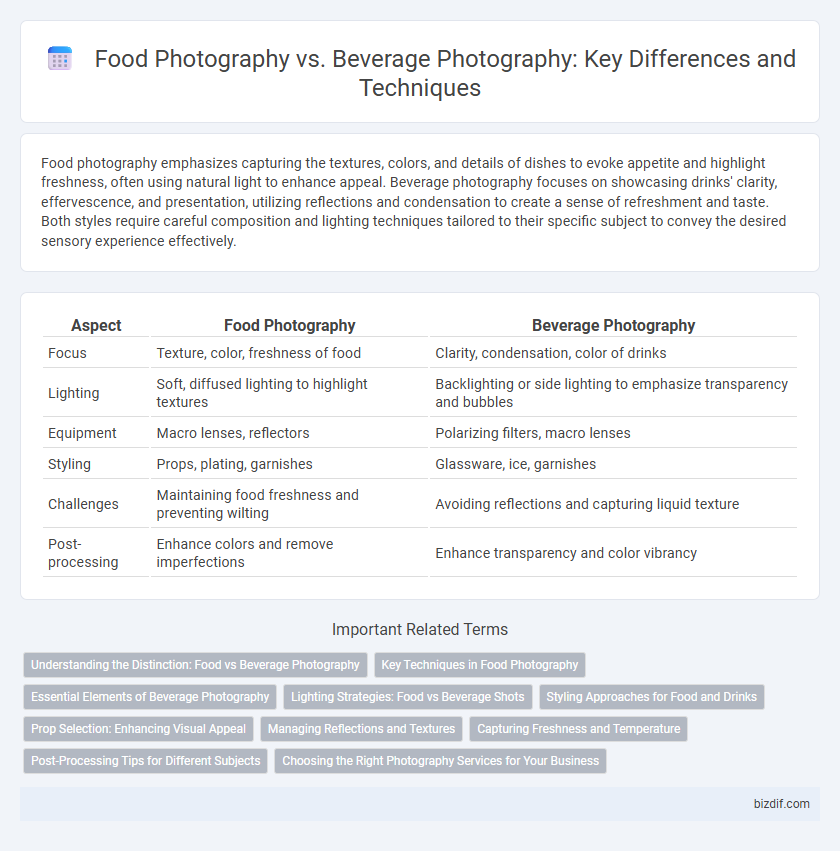Food photography emphasizes capturing the textures, colors, and details of dishes to evoke appetite and highlight freshness, often using natural light to enhance appeal. Beverage photography focuses on showcasing drinks' clarity, effervescence, and presentation, utilizing reflections and condensation to create a sense of refreshment and taste. Both styles require careful composition and lighting techniques tailored to their specific subject to convey the desired sensory experience effectively.
Table of Comparison
| Aspect | Food Photography | Beverage Photography |
|---|---|---|
| Focus | Texture, color, freshness of food | Clarity, condensation, color of drinks |
| Lighting | Soft, diffused lighting to highlight textures | Backlighting or side lighting to emphasize transparency and bubbles |
| Equipment | Macro lenses, reflectors | Polarizing filters, macro lenses |
| Styling | Props, plating, garnishes | Glassware, ice, garnishes |
| Challenges | Maintaining food freshness and preventing wilting | Avoiding reflections and capturing liquid texture |
| Post-processing | Enhance colors and remove imperfections | Enhance transparency and color vibrancy |
Understanding the Distinction: Food vs Beverage Photography
Food photography captures the texture, color, and arrangement of solid dishes to evoke taste and aroma, often emphasizing plating and ingredients. Beverage photography highlights the clarity, condensation, and movement of drinks, using lighting techniques to showcase transparency and refreshing qualities. Mastering these distinctions improves visual storytelling and enhances the viewer's sensory experience in culinary imagery.
Key Techniques in Food Photography
Mastering lighting is crucial in food photography to highlight textures and colors, ensuring dishes appear appetizing and fresh. Using shallow depth of field emphasizes the main subject by blurring backgrounds, drawing attention to intricate details like steam or sauce gloss. Styling with complementary props and careful composition enhances storytelling, creating an inviting atmosphere that elevates the visual appeal of food images.
Essential Elements of Beverage Photography
Beverage photography demands careful attention to lighting and composition to capture the translucence and texture of liquids, emphasizing reflections and condensation for a fresh, appealing look. Key elements include the choice of glassware, background colors that complement the drink, and props that highlight the beverage's context or flavor profile. Mastering these components ensures the beverage appears refreshing and inviting, distinguishing it from the focused, detail-oriented approach typical in food photography.
Lighting Strategies: Food vs Beverage Shots
Lighting strategies for food photography emphasize soft, diffused light to enhance texture and natural colors, reducing harsh shadows that can distract from dish details. Beverage photography often relies on backlighting or side lighting to create reflections and highlights that emphasize transparency, effervescence, and condensation on glasses. Mastering these distinct lighting approaches ensures vibrant, appetizing visuals that effectively showcase the unique qualities of food and drinks.
Styling Approaches for Food and Drinks
Food photography styling emphasizes texture, color contrast, and ingredient freshness to create appetizing visuals that highlight flavor profiles and dish composition. Beverage photography styling focuses on clarity, condensation effects, and lighting to showcase the drink's transparency, color, and temperature, often incorporating props like glassware and garnishes to enhance appeal. Both disciplines require meticulous arrangement and lighting techniques tailored to their unique subjects to evoke sensory experiences and entice viewers.
Prop Selection: Enhancing Visual Appeal
In food photography, prop selection emphasizes textures and colors that complement the dish, such as rustic plates, wooden cutting boards, and fabric napkins, to enhance the sensory appeal and context. Beverage photography often incorporates glassware, ice cubes, and garnishes like citrus slices or herbs to highlight clarity, freshness, and the drink's characteristics. Choosing props that align with the subject's temperature, setting, and mood significantly elevates the visual storytelling and entices the viewer's appetite or thirst.
Managing Reflections and Textures
Managing reflections in food photography requires diffused lighting and matte surfaces to minimize glare while enhancing texture details for a natural, appetizing look. Beverage photography often demands careful control of reflections on glass and liquid surfaces, using polarizing filters and strategic angling to highlight transparency and condensation. Texture is emphasized in food through sharp focus and side lighting, whereas beverages rely on capturing clarity and sparkle to evoke freshness and appeal.
Capturing Freshness and Temperature
Food photography emphasizes capturing the texture and vibrant colors to highlight freshness, often using natural light to enhance the appeal of ingredients. Beverage photography focuses on showcasing temperature contrasts, such as condensation on a cold glass or steam rising from a hot cup, to evoke sensory experiences. Both styles require precise lighting and composition techniques to convey freshness and temperature effectively.
Post-Processing Tips for Different Subjects
Food photography post-processing emphasizes enhancing texture and color vibrancy to make dishes appear fresh and appetizing, using techniques like selective sharpening and color correction. Beverage photography post-processing focuses on clarity and reflection management, often involving gloss enhancement and careful highlight adjustments to capture liquid transparency and surface shine. Both require precise white balance and contrast control, but beverage shots benefit more from subtle gradients and minimizing glare for a polished, inviting look.
Choosing the Right Photography Services for Your Business
Food photography captures the texture, color, and freshness of dishes to entice customers through vivid and mouth-watering visuals, while beverage photography highlights the clarity, sparkle, and presentation of drinks to evoke refreshment and sophistication. Choosing the right photography services depends on your business goals, whether emphasizing the appeal of meals or showcasing signature drinks, and requires expertise in lighting, styling, and composition tailored to each subject. Professional photographers specializing in food or beverage will enhance your brand's visual identity and drive customer engagement by producing high-quality images that resonate with your target audience.
Food Photography vs Beverage Photography Infographic

 bizdif.com
bizdif.com